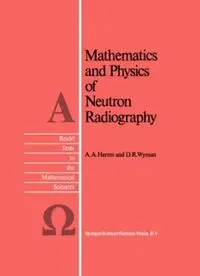
Mathematics and Physics of Neutron Radiography PDF
Preview Mathematics and Physics of Neutron Radiography
Mathematics and Physics of Neutron Radiography Reidel Texts in the Mathematical Sciences A Graduate- Level Book Series Mathen1atics and Physics of Neutron Radiography by A.A. Harms Department of Engineering Physics, McMaster University, Hamilton, Ontario, Canada and D.R. Wyman Cancer Research Foundation, Hamilton, Ontario, Canada Springer-Science+Business Media, B.V. Softcover reprint of the hardcover 1st edition 1986 Ubrary of Congress Cataloging in Publication Data CIP Harms, A. A. Mathematics and physics of neutron radiography. Bibliography: p. lncludes index. 1. Neutron radiography. 1. Wyman, D. R. (Douglas R.), 1957- 11. Title. QC793.5.N4628H37 1986 621.36'7 85-31239 ISBN 978-94-015-6939-2 ISBN 978-94-015-6937-8 (eBook) DOI 10.1007/978-94-015-6937-8 All Rights Reserved © 1986 by Springer Science+Business Media Dordrecht Originally published by D. Reidel Publishing Cornpany, Dordrecht, Holland in 1986 No part of the material protected by this copyright notice may be reproduced or utilized in any form or by any means, electronic or mechanical, including photocopying, recording or by any information storage and retrieval system, without written permission from the copyright owner. TO: U.M.C., P. & W.W. E.A.B., C.R. & F.J.W. Table of Contents Preface xi I. Introduction 1.1 Historical Evolution 1 1.2 Essential Features 2 1.3 Context and Scope 6 II. Component Characterization 2.1 Collimated Beam 10 2.2 Divergent Beam 11 2.3 Absorbing Object 13 2.4 Scattering and Absorbing Object 15 2.5 Neutron Converter 17 2.6 Converter-Recorder Coupling 19 2.7 Track-Etch Imaging 25 III. Object-Image Relations 3.1 Compositional and Geometrical Effects 27 3.2 Image Degradation 30 3.3 Line-Spread U nsharpness 32 3.4 Full-Width-at-Half-Maximum 36 3.5 Edge-Spread U nsharpness 38 3.6 Extension of the Line-Spread Function 39 IV. Rectangular Geometry 4.1 Knife-Edge Converter Response 44 4.2 Edge Location 44 4.3 Wide-Slab Object 48 4.4 Wide-Gap Object 50 4.5 Narrow-Slab and Narrow-Gap Objects 50 4.6 Partially Absorbing Objects 56 viii TABLE OF CONTENTS V. Cylindrical Geometry 5.1 Homogeneous Cylinder 59 5.2 Cylinder-Edge Location 62 5.3 Inhomogeneous Cylinder 65 5.4 Cylindrical Nuclear Fuel 68 5.5 Inclusion Signatures 72 VI. Two-Dimensional Analysis 6.1 One and Two Dimensions 75 6.2 Point-Spread Function 77 6.3 Absorbing Wedge 80 6.4 Corner Location 83 VII. Object Scattering 7.1 Scattering Degradation 86 7.2 Counting Scattered Neutrons 88 7.3 Scattering Transfer Functions 90 7.4 Infinite Slab Response 94 7.5 Knife-Edge Response 96 7.6 Neutron Build-Up Factor 99 VIII. Linear Systems Formulation 8.1 Transfer Functions and System Linearity 105 8.2 Fourier Transform 107 8.3 Modulation Transfer Functions 109 8.4 Combined Image Degradation 110 8.5 Scattering Degradation and Converter Unsharpness 114 IX. Selected Topics 9.1 Neutron-Nucleus Interactions 118 9.2 Comparison of Line-Spread Functions 120 TABLE OF CONTENTS ix 9.3 Image Degradation Classification 122 9.4 Geometric U nsharpness 123 9.5 Single Motion U nsharpness 128 9.6 Periodic Motion U nsharpness 131 9.7 Noise Degradation 133 9.8 Noise Smoothing 135 X. Neutron Radiographs 138 XI. Bibliography and References 153 Subject Index 159 Preface Neutron radiography has in recent years emerged as a useful and complementary technology for radiation diagnosis. It is now routinely used in industrial quality assurance and in support of selected research and developmental activities. Conferences are held on the subject, pertinent handbooks exist, and technical papers appear regularly reporting on new developments. While neutron radiography has indeed passed through the transition from a scientific curiosity to technological relevance, it is a sign of its continuing dynamic evolution that little material has appeared which provides an integrated mathematical and physical analysis of the subject possessing both an instructional as well as reference function. It is our hope that this monograph will fill this need. The distinctiveness of neutron radiography rests on the unique interactions between neutrons and nuclei. This leads to some special relationships between the material and geometrical properties of an object and the neutron radiographic image. The evolution of a technical discipline demands that specific conceptual constructs be developed and their mathematical representations examined and compared with controlled experiments. Experience has convinced us that a particular and substantial body of knowledge has accumulated endowing neutron radiography with the essential foundations of a unique mathematical and physical science. Our scientific and professional involvement in neutron radiography began some 15 years ago when the senior author (A.A.H.) found himself with convenient access to the McMaster University Nuclear Reactor and research support from the Government of Canada. Over the years a number of specific research projects had been undertaken generally with the aim of elucidating particular processes and establishing appropriate mathematical formulations. Graduate students were drawn in, some academic colleagues developed complementary interests, several commercial radiographic contracts were supervised, and contact with the international community of neutron radiography undertaken. This period of xi
